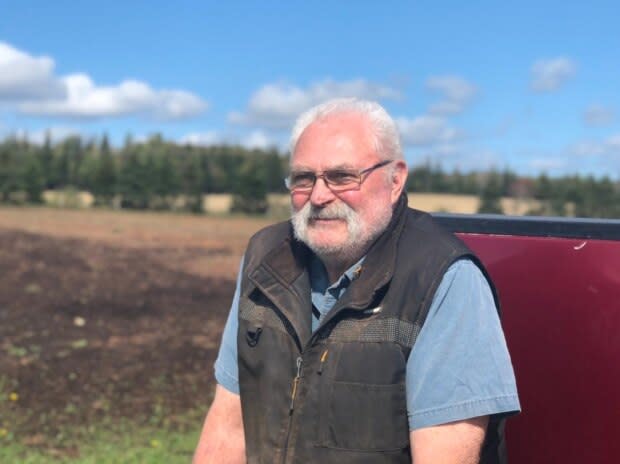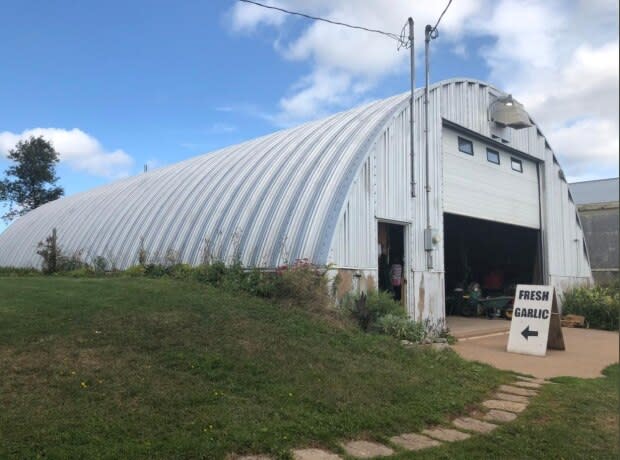Dry, hot weather creates 'perfect' season for P.E.I garlic grower
Though the dry, hot weather that came with summer 2020 was devastating for many P.E.I. farmers, it was a great year to be in garlic.
Al Picketts owns Eureka Garlic in Norboro, P.E.I., and has been growing it for about 20 years. He says this was his best year ever.
"My season, this year, 2020, was as perfect a season as I could expect," he said.
"The crop is probably the nicest, biggest looking garlic I've ever grown."
Picketts credits the success of his 2020 crop on two things: the 15 centimetres of straw he lays over the crop once planted, and co-operation from the weather.
"We've never irrigated ever, my irrigation system is straw," he said. "The straw prevents the water from evaporating from the soil.
"Because there was no rain, that means that we got a lot more sunshine. Garlic likes sunshine, garlic likes heat … if you can have heat and sun and not let the water escape, then you've got a crop."
The garlic grower and former beekeeper said the lack of rain was also good for keeping away fungi varieties, which can become a long-term challenge if they get into the soil.
45 varieties, down from 230
Picketts started off growing close to 230 varieties of garlic, but has now pared that down to a high-quality 45 varieties — including his highly-coveted black garlic — which he grows on the field behind his house.

The field itself is only about half a hectare, but Picketts makes use of the space. He plants between 90,000 and 100,000 plants in the fall and then another 17,000 in the spring.
"Most varieties and types you would plant in October. If you didn't get it in an October and the ground's still not frozen, plant it in November," he said.
Picketts said the latest he's planted garlic was Dec. 14, and it still did "perfectly well."
Picketts sells his garlic to customers across North America and here on P.E.I., both for eating and for seed garlic.
For those looking to grow garlic, Picketts has some advice: buy quality seed, get your soil ready, compost and don't let it grow for too long.
"I tell people when they're putting compost on, to put on what they think is right, and then triple it," he said. "You're not even close to what it needs."

As for the harvest, he said many amateur growers make the mistake of leaving the garlic too long.
"You want two dead leaves and a sick one, now it's time to bring it home," he said.
"There's still lots of greenery on top, but now is the time."

He also recommends using fertilizers like sulphate of potash and bone meal, both of which he sells in individual baggies from a folding table inside the hanger on his Norboro property, for customers coming to buy seed garlic.
"We try to have something for most people that come in," Picketts said.
"With the way I grow garlic, we're making a living, I guess you could call it a living, for my wife and I."
'It makes all the difference'
For Picketts, garlic is a labour of love.
His day starts around 6 a.m. and he works until 8 or 9 p.m., sometimes taking a nap in the afternoon when he gets tired. This is his routine, seven days a week.
"Doing all of this on an acre and a quarter, it doesn't seem possible, but it is," he said. "Garlic, it takes all our time. I'm out here working as long as I can work."

There are about eight people working on the operation, which is all done by hand. Picketts said this is because of the precision and care required for garlic, which he says is fragile like eggs.
"I don't know what machinery can really be gentle with them, because you'll end up with a bit of a mess," he said.
Picketts doesn't know how much garlic he grew this year, and he's never known, since he doesn't count or measure. What he does know is that this is his best season, since the bulbs are so full and big.
"We don't necessarily have more bulbs of garlic, But if you took all the bulbs of garlic and you increased the diameter by quarter of an inch, it makes all the difference," he said.
For Picketts, there won't be much time to enjoy the spoils of a fruitful harvest — he said he'll start planting next year's crop on Oct. 1.
More from CBC P.E.I.


